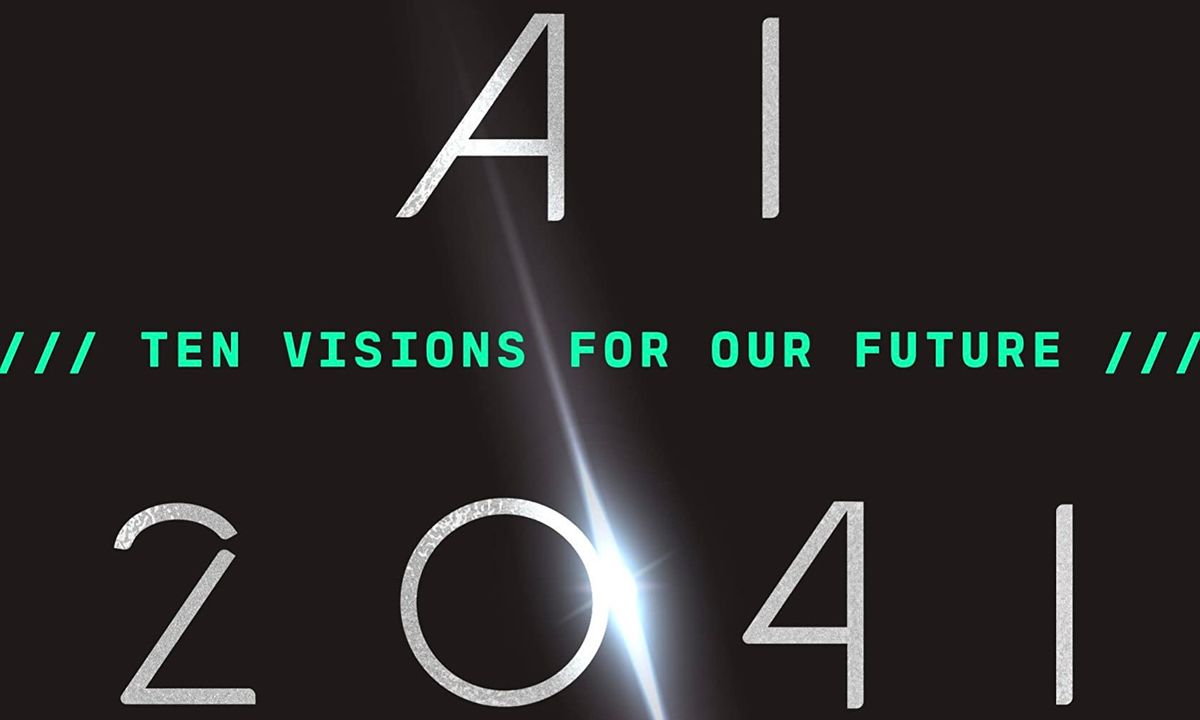AI 2041 by Kai-Fu Lee Summary
Kai-Fu Lee is an AI expert and former VP of Google China. In this book, he predicts the future of technology in the year 2041.

Chapter 1
Deep Learning, Big Data, Internet/Finance Applications, AI Externalities
Human sexism, racism, and other biases could unknowingly find their way into AI because AI is based on human data. AI can even distinguish gay people based on facial movements. We need to find a way to mitigate this bias.
Chapter 2
Computer Vision, Convolutional Neural Networks, Deepfakes, Generative Adversarial Networks (GANs), Biometrics, AI Security
Blockchain technology could stop next-generation deep fakes by having each video or picture be authenticated on the blockchain.
Irises and fingerprints are unique to the individual. They could be the best bio identification we have. Real-time biosensors could stop deep fakes. Iris recognition is the most accurate.
There are ways to trick AI like wearing a mask or putting stickers on road lines.
Chapter 3
Natural Language Processing, Self-Supervised Training, GPT-3, AGI and Consciousness, AI Education
NLP is the ability for computers to take in and process human languages. OpenAI's Gpt-3 is an example.
In the future, everyone will have an AI companion.
AI will greatly enhance education. Imagine lessons that are tailored to the individual. Programs that are as good at recommending educational videos as YouTube is at recommending entertainment videos.
Keep a close eye on this field. Imagine if Gpt-3 could write reports for you or answer questions like “If COVID comes back in the fall, how should I restructure my portfolio?” Having access to something that has super human strategy could be a huge competitive advantage if used correctly.
For AI to actually take everyone’s job, it would require a massive breakthrough in machine learning akin to Einstein's theory of relativity. As it works now, AI is like a super human data analyst but it can’t, say, cook you dinner.
We may need to re-envision the computer chip to make it more like a brain and then create new programming languages to write programs for these new chips.
GPT-3 is only the first version. As compute scales, maybe GPT-23 in 2040 will have analyzed all of the text in the world and watched all of the videos.
GPT-3 contains 175 billion parameters, making it 17 times as large as GPT-2, and about 10 times as Microsoft's Turing NLG model.
Lagging areas: how to model creativity, thinking, reasoning, counterfactual thinking, emotions, and consciousness. These will require at least a dozen breakthroughs on the level of deep learning to figure out. But we’ve had only 1 great breakthrough in over 60 years.
Chapter 4
AI Healthcare, Alphafold, Robotic Applications, COVID Automation Acceleration
Healthcare is just now being digitized. Teledoc, One Medical, Amazon health. Once these companies collect enough medical data, we will begin to see the benefits of medical AI.
Open source data sets can get larger and better over time. Cloud machine learning services can be offered at reasonable prices like AWS. This will allow more people to develop AI systems.
Wearables (like the Apple watch) can constantly track health markers and notify the wearer if anything is wrong.
Drugs work by binding to the pathogen—the same way the pathogen bound to the human to make them ill. Drug discovery is finding this treatment molecule in the following 4 steps:
- Use mRNA sequence to derive the pathogens protein sequence (relatively easy).
- Find the 3D structure of the pathogen’s protein sequence—protein folding.
- Identify the target on that 3D structure.
- Generate likely treatment molecules. Then select the best pre-clinical subject from them.
Steps 1-3 figure out the lock and step 4 makes the key to the lock. Steps 2-4 are time-consuming and costly.
mRNA vaccines are a new technology that speeds up the system.
AI will reduce the cost and time required to develop new drugs. Deepmind’s Alphafold 2 is the greatest contribution to science from AI so far. Alphafold 2 gives results similar to the leading process for step #2 above—this will greatly speed up the process. Then we can take established drugs and see if they can be repurposed to work for a new pathogen. Repurposed drugs are great because they can be deployed without having to go through testing like a new drug because they’ve already been tested. This speeds up the process and could theoretically stop a future pandemic before it starts or gets out of control.
AI NLP can help speed up #3 and #4 by reading more papers than any human can and searching for something that could work.
Over time, AI can develop personalized drugs that take the individual's medical history and genomics into account.
AI is already better than human radiologists for certain types of MRI and CT scans. Over time, they will be better than all but the best doctors.
Robots will do more and more surgeries. Starting with surgeon-assisted robots.
Physical robotics problems will take longer than digital AI for finances, healthcare, etc because they have a physical component that must be engineered.
By 2041 warehouses will be fully automated and factories will be mostly automated.
Agriculture can be done by drones or robots. This will reduce the cost of food.
Chapter 5
Virtual Reality (VR), Augmented Reality (AR), and Mixed Reality (MR), Brain-Computer Interface (BCI), Ethical and Societal Issues
XR includes VR, AR, and MR.
XR is like dreaming with your eyes open.
AI will be good enough to create a person’s likeness in an XR experience.
Contact lenses could be what takes AR mainstream.
Ear sets using bone conduction or other technology could be used to send audio to the user in a very inconspicuous way.
Omni-directional treadmills like in the movie Ready Player One will be used for XR.
Inputs will likely be done with BCIs. There are problems with BCIs, they continually probe the brain which damages it over time. Also, they only connect to certain neurons, so connection is limited.
Chapter 6
Autonomous Vehicles, Full Autonomy and Smart Cities, Ethical and Social Issues
Kai-Fu thinks that autonomous vehicles (AV) will not be mature until 2041.
Kai-Fu proposes changing the city to accommodate AVs. Paint better lane lines or even have certain areas away from pedestrians that AVs drive on.
Chapter 7
Quantum Computers, Bitcoin Security, Autonomous Weapons and Existential Threat
Quantum Computers
Quantum computing could hack a bitcoin public key to its private key. But there may be a bitcoin update that makes only the hash public and not the public key—then the quantum hackers would have nothing to go on, theoretically.
P2Pk vs P2PKH
Quantum computing has an 80% chance of working by 2041 according to Kai-Fu. Quantum computing could have a greater impact than AI.
“A quantum computer (or “QC,” which is also used to refer to quantum computing in general) is a new computer architecture that uses quantum mechanics to perform certain kinds of computation much more efficiently than a classical computer can.”
“The second property is entanglement, which means two qubits remain connected so that actions performed on one affect the other, even when separated by great distances. Thanks to entanglement, every qubit added to a quantum machine exponentially increases its computing power. To double a $100 million classical supercomputer, you’d have to spend another $100 million. To double your quantum computing, you just need to add one more qubit.”
QCs require super cooling and vacuums and stability or they lose functionality. This is what makes creating QCs difficult. When the QC stops working because of these issues it is called decoherence.
“Google demonstrated “quantum supremacy” for the first time in 2019, proving basically that a 54-qubit QC can solve a problem (in this case, one that happened to be useless) in minutes that would take classical computers years.”
The number of qubits has been doubling every year. Some people project this forwards and predict that QCs will be functional in 5-10 years. Functional enough to hack bitcoin.
In real life, it takes way more qubits than is theoretically necessary because of decoherence. But regular computers were once the size of a room and are now the size of a smartphone.
QC could be used for evil—hacking bitcoin to take people’s money. Or it could be used for good—using QC to develop new drugs quickly.
“QC will be able to model many complex natural phenomena that classical computers cannot fathom, even beyond drug discovery: for example, figuring how to counteract climate change, predicting pandemic risks, inventing new materials, exploring space, modeling our brains, and understanding quantum physics.”
“Finally, quantum computers’ impact on AI won’t just be a matter of making deep learning faster. Programming a QC involves giving it all potential solutions represented with qubits, and then scoring each potential solution in parallel. Then, the QC will attempt to find the best answer in very little time. This could potentially revolutionize machine learning and solve problems that were viewed as impossible before.”
Good summary of Bitcoin encryption and how private and public keys work: “The RSA algorithm is used for Bitcoin and some other financial Internet transactions and digital signatures. The RSA algorithm, like all asymmetric cryptography algorithms, uses two keys, the public key and the private key. The two keys are very long sequences of characters that are mathematically related. The transformation from private to public is very simple, while the reverse is practically impossible to accomplish on classical computers. When you send bitcoins to me (say, for a purchase), you send them with a script of information that effectively serves as a publicly posted “deposit slip” (or transaction) that has my account (or Bitcoin wallet address) as the public key. While everyone can see this public key, only I have the private key that serves as the digital signature that can open the deposit slip. I complete the transaction by signing with my private key. This process is perfectly secure, as long as no one has my private key.”
“With quantum computing, all that is changed, because unlike classical computers, QC can quickly generate the private key from any public key for RSA or similar algorithms as used by bitcoins of today. So, the quantum computer simply accesses the public ledger (where all transactions are posted), takes each public key, uses the QC to generate a private-key digital signature, and takes all the bitcoins from the accounts that are not empty.”
Quantum only allows you to hack old P2PK accounts: “You might be wondering: Why would people post their wallet address and public key openly to the world? This was an early design flaw. Bitcoin experts later realized that was both unnecessary and dangerous. In 2010, essentially all new transactions shifted to a new format that includes the address but hides it, which is a lot safer (though not completely immune to attack). This new standard is called P2PKH. But there are still two million bitcoins stored in the old vulnerable format (called P2PK). And at the January 2021 price of $60,000 per bitcoin, that comes out to $120 billion worth of bitcoins. This is what thieves went after in “Quantum Genocide.” If you have an old P2PK account, put this book down now and go secure your wallet!”
Why can’t quantum hack banks?: “banks do not have a public ledger with public keys from which private keys can be computed. Second, banks have software to monitor for anomalies such as large suspicious transfers. Third, the movement of money between accounts can be traced, and prosecuted if laws are broken. Finally, banking transactions are protected by a different cryptography algorithm that will take a bit more effort to decode.”
“What could be done to “upgrade” our cryptography? Quantum-resistant algorithms exist. In fact, Professor Shor also showed that impregnable cryptography could be built on QC. A symmetric cryptography algorithm based on quantum mechanics is impregnable even if the intruders have a powerful quantum computer. The only way to infiltrate this cryptography is if the principles of quantum mechanics are found to be incorrect.
But quantum-resistant algorithms are very expensive computationally, so they are not being considered right now by most commercial and Bitcoin entities. Perhaps only after the inevitable quantum bitcoin heist happens will people wake up to revamp the algorithms. I hope it won’t take that long!”
AI Weapons
“Autonomous weaponry is the third revolution in warfare, following gunpowder and nuclear arms.”
AI drones as cheap as $1000 could be used for assassinations—this has huge political implications. Imagine any terrorist can kill a political leader with only $1000.
- These drones are autonomous—they seek out a specific target, eliminate it, and evacuate—no remotes, no humans needed.
“A swarm of ten thousand drones that could wipe out half a city could theoretically cost as little as $10 million.”
- Swarms are virtually unstoppable.
Chapter 9
AI and Happiness, General Data Protection Regulation (GDPR), Personal Data, Privacy Computing Using Federated Learning and Trusted Execution Environment (Tee)
“Google knows everything you’ve ever searched, every place you’ve been to (through Android analytics and Google Maps, unless you turned off location history), every video you’ve watched, every email you’ve sent, everyone you’ve called on Google Voice, and every meeting you’ve scheduled in a Google calendar. Trained on this data, Google can deliver tailored services that are incredibly convenient for you. Google and Facebook have access to so much data, they can infer your home address, ethnicity, sexual orientation, and even what makes you angry. They can guess your innermost secrets, whether you cheated on your taxes, are an alcoholic, or had an extramarital affair. These inferences will have a fair amount of errors, but even the notion that these companies have the tools and your data to attempt to guess likely makes one uneasy.”
GDPR: general data protection regulation laws are in effect in the UK and they limit the data that companies can gather.
GDPR isn’t perfect because companies actually need data to make good products and the customers usually don’t understand and therefore don’t know what they’re consenting to when they accept terms of using the app.
There could be an AI that learns our preferences and has info on the trustworthiness of the business. This individualized AI can selectively allow companies certain data that all for the beat UX for the customer.
Who can we trust with all of our data? Can we trust the individualized AI from above? We need to find an entity that has incentives aligned with the consumers.
- There could be a non-profit AI like Wikipedia.
- There could be communities where people volunteer their data.
- There could be a blockchain for data. The data itself will be distributed among nodes so nobody can see or hack it but whoever has a key can view it.
Chapter 10
Plenitude, New Economic Models, The Future of Money, Singularity
Post-scarcity could occur by 2041.
This post-scarcity would only be for developed countries. And there will never be a true post-scarcity because, for instance, there are only 20 da Vinci pairings—some things will always be scarce.
We already have enough food and housing for everyone—but a lot of food goes to waste and a lot of housing is owned but unoccupied—we already have abundance but we do not have equitable distribution of it.
“The father of modern economics, Adam Smith, theorized that by giving everyone the freedom to produce, exchange, and consume based on their self-interest, economies will naturally balance and continue to grow. Karl Marx argued that the increasing power of capital will invalidate Adam Smith’s theory, as it gives inordinate power to those who control capital, leading to inequality and exploitation of the working class. John Maynard Keynes shared the concern that “natural balance” will take too long but advocated using monetary policies to modulate the economy to increase demand and decrease unemployment. One thing all three theories have in common is the underlying assumption of scarcity.
In the future, if the scarcity assumption is nullified, so would these economic models. When there is no scarcity, then all mechanisms such as selling, buying, and exchanging will no longer be needed. Money will arguably also no longer be needed. What, then, is the economic model?”
Social status and respect become more important as we move up Maslow’s hierarchy of needs. Especially once money is no longer needed.
Altruistic endeavors can become status symbols. People who go out to save the Great Barrier Reef or develop something to fight climate change could either get status, fame, or an NFT that proves their accomplishment.



Comments ()